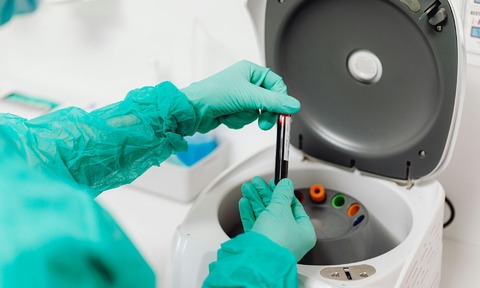
From eco-friendly materials to innovative technologies such as spectroscopy, molecular diagnostics is evolving to reduce its environmental footprint while improving accessibility and efficiency. Rachel Sully explains how rethinking materials, workflows and technologies is driving a more eco-conscious future in the area, from lab to point-of-care applications.
Molecular diagnostics help identify diseases, or the risk of developing a disease such as cancer, by studying nucleic acids and proteins in tissue or fluid samples. The different types of molecular diagnostics tests include biomarkers, tumour sequencing, genetics and liquid biopsies, with analysis often being carried out using molecular biology techniques such as nucleic acid isolation and quantification, PCR amplification, sequencing, and short tandem repeat (STR) analysis.
If not properly managed, these laboratory techniques contribute significantly to environmental pollution, as they often rely on chemicals, plastics and other consumables, such as PCR tubes and reagents. In June 2021, the European Commission published the Green & Sustainable Laboratories initiative, proposing several actions to improve sustainability in labs, including adopting sustainable medical technologies and materials and more efficient waste management. There are many practices that can be implemented to fulfil this initiative, including encouraging the use of eco-friendly materials.
From production to disposal, the lifecycle of diagnostic products is an area where sustainability plays a critical role. Companies are increasingly focusing on making molecular diagnostic products that are not only effective but also easy to dispose of or recycle after use. Some companies are exploring packaging and distribution methods that minimise carbon footprints, supporting broader sustainability goals.
Reusing and recycling diagnostic equipment can help minimise the environmental footprint. This reusing and recycling initiative can also be applied to waste diagnostic tests. For example, London South Bank University, in collaboration with altona Diagnostics UK Ltd, uses near-expiry molecular diagnostic kits for practical clinical microbiology training. These kits, otherwise discarded, are repurposed to provide handson experience with PCR-based diagnostic tools. This model promotes sustainability in education while equipping students with critical skills for the workforce, demonstrating a practical approach to integrating environmental and educational goals.
Spectroscopic techniques have several advantages over traditional techniques, making them more environmentally friendly and sustainable. Many spectroscopic instruments can be used repeatedly without needing single-use consumables, unlike some traditional diagnostic tests, reducing waste generation. Techniques such as Raman and Infrared spectroscopy are nondestructive techniques allowing for multi-sample analysis. They can also analyse samples without the need for reagents and without producing waste, reducing the environmental footprint in comparison to traditional methods.
Spectroscopy can detect molecular signatures without the need for fluorescent or radioactive labels, which often require hazardous chemicals and complex disposal procedures.
Advances in portable spectroscopy devices allow on-site diagnostics, reducing the need for large infrastructure and energy-intensive transportation of samples to central labs. Miniaturised devices use smaller quantities of power and materials, further supporting sustainable practices.
The sustainable development of molecular diagnostic tests requires them to have a low environmental impact. This can be achieved by using biodegradable and bio-based materials which reduces plastic waste; using microfabrication processes to reduce energy consumption during production; and developing portable and rechargeable diagnostic systems, reducing the amount of waste generated by consumables.
Digital technologies like artificial intelligence and quantum computing are driving safer, more sustainable molecular diagnostics by optimising production and analysis processes
Other changes that can be implemented include optimising reagents used – such as lyophilisation and air-drying. Incorporating lyophilisation and airdrying techniques into the manufacturing of molecular diagnostics tests eliminates the need for cold-chain storage, reducing energy consumption and also extending shelf life. Airdrying is even more sustainable as it has lower equipment and energy costs than lyophilisation.
Digital technologies like artificial intelligence and quantum computing are driving safer, more sustainable molecular diagnostics by optimising production and analysis processes.
These technologies can help deliver safer and more sustainable chemicals and materials by design. The digitisation of diagnostic data reduces the amount of paper and plastic needed to store test results.
Molecular diagnostics tests often require significant energy input, especially in highthroughput settings. Therefore these digital processes need to be made more sustainable. With advancements in digital diagnostics, more energy-efficient technologies are being developed. These innovations not only lower operational costs but also contribute to less energy consumption per test, promoting both economic and environmental sustainability.
Recently, there have also been advances into creating point-of-care molecular diagnostics tests, enabling highly specific and sensitive testing at the patient site. Often these tests are significantly less time-consuming than lab-based tests and allow for immediate visualisation of DNA synthesis. For example, isothermal amplification takes around 30 minutes rather than the 90 minutes that PCR takes. Point-of-care tests also often utilise phone apps as readers for live data visualisation of test results. Point-of-care molecular diagnostics tests reduce environmental impact by enabling on-site testing, eliminating energyintensive transportation, and minimising reliance on single-use plastics. Replacing venous blood collected by a phlebotomist for fingerprick testing or other methods would immediately eliminate a significant portion of the carbon emission attributed to sample collection.
By integrating spectroscopy into point-of-care devices, diagnostics can be performed rapidly and locally, reducing the energy and emissions associated with central lab testing. This approach also minimises sample handling and storage requirements, lowering the need for single-use plastics and other disposable materials.
Sustainability in molecular diagnostics is also linked to global access. Ensuring that diagnostic tests are affordable, accessible and adaptable for use in lowand middle-income countries is a key aspect of sustainable health solutions. Reducing costs through innovation, such as using fewer resources or developing point-of-care devices, allows for more widespread adoption, especially in regions where healthcare infrastructure is limited.
In summary, there are three key strategies that can be considered as a guideline to sustainably develop molecular diagnostics tests: applying alternative sample types and patient collection; lyophilising or air-drying reagents eliminating cold-chain transport and storage; and reducing assay workflow, in turn reducing the amount of consumables used.
Dr Rachel Sully is senior formulation scientist at SiSaf

